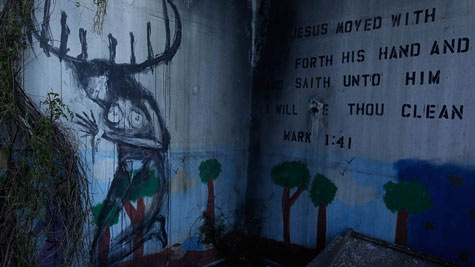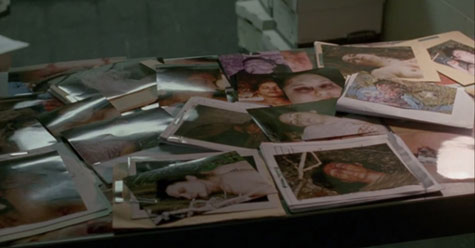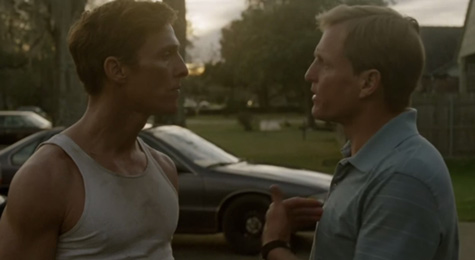 True Detective's third episode commits the storytelling to deceptive minimalism, opening with Rust and Martin staring at pagan graven image in the burnt wreck of an abandoned church at night, looking like nothing less than anthropologists discovering the eerie Cro-Magnon cave paintings at Lascaux. And at the heart, that is what this story is; pulling at a thread of one disturbing murder to unravel the gauze hiding old dark secrets of human nature. Are we the moral creatures Martin believes us to be, or are we as Cohle has pegged us, evolutionary errors with consciousness as a mistake, a side effect of being like living cancer cells, dividing like mad across the earth and spreading hate and hypocrisy?
True Detective's third episode commits the storytelling to deceptive minimalism, opening with Rust and Martin staring at pagan graven image in the burnt wreck of an abandoned church at night, looking like nothing less than anthropologists discovering the eerie Cro-Magnon cave paintings at Lascaux. And at the heart, that is what this story is; pulling at a thread of one disturbing murder to unravel the gauze hiding old dark secrets of human nature. Are we the moral creatures Martin believes us to be, or are we as Cohle has pegged us, evolutionary errors with consciousness as a mistake, a side effect of being like living cancer cells, dividing like mad across the earth and spreading hate and hypocrisy?
True Detective works on a surface level as the story of two men who solved a brutal crime at the cost of their personal sanity, only to be called back to replay it by Monday morning quarterbacks 17 years later, but the subtext is equally engrossing. It plays on our expectations of a police procedural and a serial killer drama, by flashing the lure of the crime story as little as possible. It knows we know how those stories go, and wastes very little time with montages of the monotony of detection, and the sheer volume of brutal murders.
Editor's Note: Read on if you're spoilerproofed…
In episode three, “The Locked Room,” we watch Rust Cohle pore over a collage of crime scene photos of dead women, and instead of the vicarious, cathartic rage for the senseless deaths we expect, he sees relief in their eyes. Relieved that they can drop the act, the sham of existence, the burden of self-deception and denial.

The Locked Room is our own skull; the old Descartian question: if we were brains in jars, fed false stimuli, how would we know? Is the world all an agreed-upon illusion, a curtain held up only by our desperation to believe in it? In the previous episode, “Seeing Things,” we experienced Cohle's hallucinations. A swarm of birds swirled into the whirlpool Ouroboros symbol tattooed on Dora Lang's back. The lights on the highway swim and surround him like spirits or comets in the lonely void of space. In this episode, he confesses that he has synesthesia, a condition of experience where the senses meld. In his case, a color can bring a scent, a feeling. Playing into his supersensory sense of smell, Cohle may also be an “evolutionary mistake,” a kind of human bloodhound, a mystic.
Dora Lang painted the anthropomorphic beast on the wall of the church, and she became it in death. A human with deer antlers, part deer. Another word for deer is hart. Martin Hart. The beastly part of man. “Martin” comes from Mars the god of war, and Woody Harrelson plays this two-faced creature with stunning skill. The war stag, fierce yet vulnerable. In “Seeing Things” we saw the other side of his double life, his affair with Lisa Tragnetti (Alexandra Daddario) the young court reporter. He feels protective of her, yet he is the most dangerous man in her life. When he runs into her on a double-date that his wife Maggie set up to get Rust Cohle some companionship, he follows Lisa home and assaults her new boyfriend.
The more we see of Hart's family life, the more Cohle's monk-like existence seems preferable. Hart's wife sees him as a chicken-shit shadow of the man she married, and he hides behind a Gary Cooper-esque laconic mask reminiscent of Tony Soprano opining for the days of when men just did things and weren't expected to talk about it. His daughter is sent home from school for drawing inappropriately sexual doodles “on a dare,” but they sure look a lot like the poses she had her Barbies and Kens in, during the previous episode. And instead of seeing the clue in front of his face, Hart mouths platitudes and stares over her shoulder at the game. Like the image of the two girls rocking the boat earlier, we see hints of the tragedy to come.

Consumed with guilt over his own trespasses, Hart sees fault in everyone else. He asks Rust if he thinks he's a bad man. The response? “The world needs bad men. We keep other bad men from the door.” And as the episode ends with the first sighting of their suspect, a meth dealer wearing a gas mask that flops like an elephant's trunk, the beast-man imagery continues, as if humanity knows it is alone in the dark, the only animal that knows it will die. A forest creature crowned with a locked room, the unique oversized brain that gives us the joy and torture of consciousness. Let's not forget that “Locked Room” mysteries are a favorite puzzle of the crime genre, and that the flashbacks may very well be reenactments of the story told by two unreliable narrators. How much is truth and how much is the illusion we want to see?
Thomas Pluck writes unflinching fiction with heart. He is the author of Blade of Dishonor, an action thriller spanning Shogun-era Japan to WWII, and the editor of Protectors: Stories to Benefit PROTECT, an anthology of crime fiction for charity. You can find him on Twitter as @thomaspluck.
